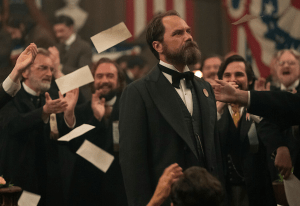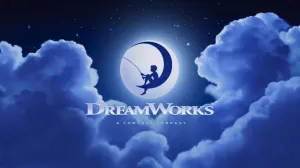Prime Video invites viewers into the Second Age of Middle-earth in its new fantasy epic, The Lord of the Rings: The Rings of Power. Amazon is betting big on The Rings of Power, pouring a budget to rival a dragon’s hoard into the series as it chronicles events in Middle-earth leading up to the War of the Last Alliance against Sauron. The show successfully brings Middle-earth to life, wonderfully realizing J.R.R. Tolkien’s fantasy realm in all its splendor. However, its narrative is somewhat unwieldy and lacks the sense of adventure that characterizes the iconic Middle-earth tales.
Videos by ComicBook.com
The Rings of Power begins about 1,000 years after the final battle against Morgoth, the first Dark Lord who was Sauron’s master. Sauron escaped capture, and Galadriel (Morfydd Clark) has spent the past millennia searching for him. Though Sauron remains at large, a new era of peace is declared, and the peoples of Middle-earth must set about repairing the various damages of personal and political natures done by more than 600 years of conflict.
That war casts a lingering pall that informs most of The Rings of Power‘s narrative in a way that contrasts with The Lord of the Rings, where it’s the encroaching shadow of a new war that threatens Middle-earth. In The Rings of Power, the aftermath of war is everywhere. Galadriel struggles to lay down her sword. In the south, Elves continue to keep close watch over the descendants of Men who sided with Morgoth, breeding resentment. Meanwhile, Elven lords such as High King Gil-Galad (Benjamin Walker) and the great smith Celebrimbor (Charles Edwards), feeling guilt over having brought war to Middle-earth’s shores, seek ways to repair the damage through beauty and art. It creates a more subdued atmosphere as if the whole world is going through a period of mourning. Bear McCreary’s often somber, even bittersweet score helps draw out that feeling.
The Rings of Power brings to life the sprawling world of Middle-earth — from the idyllic golden fields in the south to the foreboding, snowcapped mountains in the north, to the halls of Moria beneath the earth — in epic fashion. The digital backgrounds appear off at times, especially in intimate shots. However, there are moments when The Rings of Powers‘ Middle-earth looks like a Ted Nasmith painting brought to life, which is about as much as a Tolkien lover can hope to see.
But as wondrous as the world of Middle-earth appears, it’s also spread narratively thin. Where The Hobbit and The Lord of the Rings are quest stories (retake the Lonely Mountain, destroy the Ring), The Rings of Power begins with a quest’s possibly premature end as Galadriel’s search for Sauron ceases. Instead, The Rings of Power‘s first two episodes focus more on mysteries that may signal a growing evil. This approach, coupled with an ensemble cast spread across various regions of the world, makes it hard not to compare the series to Game of Thrones. The pacing lacks the urgency of adventure and, while there are fantastical elements, these feel more like garnishes rather than part of the main course.
That’s not to say that it’s a joyless affair. There are great performances throughout, including Clark as a Galadriel, who dances much closer to the darkness than one might expect from the future Lady of Lorien. There’s strong chemistry between Clark and Robert Aramayo as Galadriel’s friend Elrond, who at this point is but an ambitious young politician. However, the dwarves — Owain Arthur as Durin and Sohpie Nomvete as Disa — make the strongest impression. Perhaps it’s because their unrestrained enthusiasm is such a contrast against the stoicism of the Elves in the cast and the subdued nature of the Men of Middle-earth (at least the Men of the continent, as we haven’t made it to Numenor just yet), but they add extra vibrancy to every scene in which they appear.
The Lord of the Rings: The Rings of Power is a series with good bones. It has a strong cast, the action is stellar, and the plots are interesting. Yet, I was left wanting something more. I don’t want to be interested, I want to be excited, and these two episodes didn’t quite get me there. It’s that lack of adventure that holds it back. Of course, it was always going to be something like this. Tolkien revealed the Second Age through a historical recounting in The Silmarillion, a wholly different beast than The Hobbit or The Lord of the Rings, one that has stymied the interest of plenty of fans of Tolkien’s other works. It could be that two episodes aren’t enough to do writers J. D. Payne and Patrick McKay’s plans for Middle-earth justice (as noted, we don’t even make it to Numenor, where several new cast members await). It could be that we’re seeing the slow formation of a fellowship that will seek out Sauron wherever he is hiding, offering that quest the series seems to be lacking.
I’ll certainly be sticking around to see if that’s the case. The engrossing recreation of Middle-earth and great turns by the cast are enough to earn that. And I don’t want to judge The Rings of Power for not being something it had no intention of being — the people behind the show have said it’d be a different kind of Middle-earth story, and it is that. I only hope that, over the course of its first season, The Rings of Power picks up the pace and gives a more concise form to the story it’s seeking to tell.
Rating: 3 out of 5
The Lord of the Rings: The Rings of Power debuts September 1st on Prime Video.








